Pork ’n Beans: the more you eat, the more you….
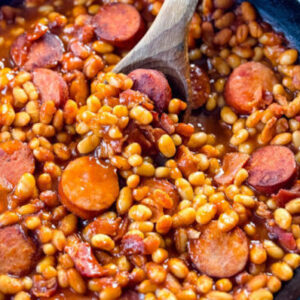
Looking back at my early childhood, I honestly believe that if it weren’t for beans, our family might’ve starved. It seemed that most of our suppers included one of the tasty legumes in my mom’s repertoire - pinto beans (my father’s favorite), Great Northern and navy beans, large limas (also known as butter beans), black-eyed peas, crowder peas, and occasionally red kidney or black beans.
And while I loved every pot of Momma’s slow cooked beans—simply seasoned with ham hock, salt, pepper, and a few herbs—one of my favorite childhood dishes was pork ’n beans. Especially when she mixed in slices of cheap wieners, topped them with crunchy canned fried onions, and baked the whole thing for an hour or so.
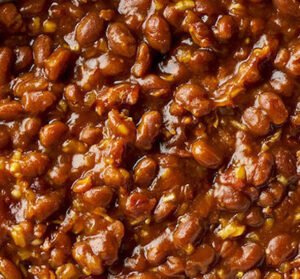 The exact origin of pork and beans is murky at best. What we do know is that ancient European cooks were known to flavor peas and other legume dishes with preserved meats. The English referred to these meals “pease porridge,” the French called them “bouillon de pois,” and the Italians “pudding di piselli.” Here’s a typical Italian recipe for “Dish Made from Peas” from the year 1475:
The exact origin of pork and beans is murky at best. What we do know is that ancient European cooks were known to flavor peas and other legume dishes with preserved meats. The English referred to these meals “pease porridge,” the French called them “bouillon de pois,” and the Italians “pudding di piselli.” Here’s a typical Italian recipe for “Dish Made from Peas” from the year 1475:
“Let peas come to a boil with carob. When they are taken form the water, put in a frying pan with bits of salt meat, especially that balanced between lean and fat. I would wish, however, that the bits had been fried a little beforehand. Then add a bit of verjuice, a bit of must, or some sugar and cinnamon. Cook broad beans in the same way.”
— Platina: In the Right Pleasure and Good Health (from the De Honesta Voluptate et Valetudine, as translated by Mary Ella Milham)
In America, baked bean dishes, including pork and beans, are thought to have originated with the indigenous Penobscot, Narragansett, and Iroquois tribes, who slow-cooked beans in clay pots buried in holes filled with hot stones. They flavored their bean creations with onions, maple syrup, and bits of meat and fat. Seventeenth-century European colonists quickly adopted this native cuisine, combining it with Old-World bean-cooking techniques to develop their own flavors and variations.
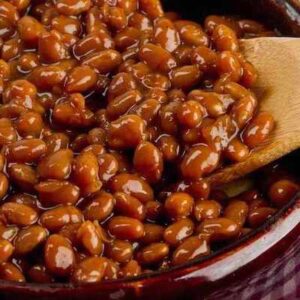 The first recorded recipe for pork and beans appeared in the 1829 edition of The American Frugal Housewife by Lydia Maria Child. It called simply for beans, salt pork, and black pepper. By 1886, Estelle Woods Wilcox, in Practical Housekeeping: A Careful Compilation of Tried and Approved Recipes, was recommending the addition of a little molasses and slow baking baking. She noted, “This is the Yankee dish for Sunday breakfast.”
The first recorded recipe for pork and beans appeared in the 1829 edition of The American Frugal Housewife by Lydia Maria Child. It called simply for beans, salt pork, and black pepper. By 1886, Estelle Woods Wilcox, in Practical Housekeeping: A Careful Compilation of Tried and Approved Recipes, was recommending the addition of a little molasses and slow baking baking. She noted, “This is the Yankee dish for Sunday breakfast.”
Yes, pork and beans—and baked beans more broadly—were originally part of the Sabbath breakfast meal. In keeping with Puritan observance, housewives were not allowed to cook from sunup to sundown Sundays, So they baked a large pot of beans overnight on Saturday and served them Sunday morning with codfish cakes and brown bread. Leftover beans were eaten for lunch.
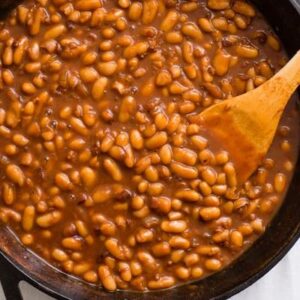 By the late 1800s, pork and beans were a staple of the Old West. On the prairies of the Great Plains, chuckwagon cooks fed hungry, trail-weary cowboys food that was fast, filling, and easy to transport. Canned (and sometime dried) beans, slab bacon, hot biscuits, canned tomatoes, and strong coffee were standard fare.
By the late 1800s, pork and beans were a staple of the Old West. On the prairies of the Great Plains, chuckwagon cooks fed hungry, trail-weary cowboys food that was fast, filling, and easy to transport. Canned (and sometime dried) beans, slab bacon, hot biscuits, canned tomatoes, and strong coffee were standard fare.
In boomtowns like Deadwood, Tombstone, and San Francisco, a nickel beer often came with a free lunch buffet of beans, bread, potatoes, and sausages. Though canned pork and beans were certainly available, most establishments favored making their beans from scratch—like this recipe found in the 1886 edition of Cooking for Profit by Jesus Whitehead:
“Baked Pork and Beans.
Wash and pick over a large heaping cupful of navy beans and steep them in water over night. Put them on next morning with fresh water to more than cover, and baking soda the size of a bean and let boil about an hour. Then carry them to the sink, pour all into a colander letting the water run away and put back into the saucepan with cold water enough to come up to a level. Boil again and in a few minutes they will be soft. Season with a little salt and tablespoon of molasses. Put them into four pint bowls or tin pans, lay an ounce slice of salt pork on each and bake half an hour.”
 Commercially canned pork and beans—often called America’s first convenience food—are credited to Gilbert Van Camp, a trained tinsmith and grocer. In 1861, Gilbert and his wife Hester, began canning fruits and vegetables for their Indianapolis family store. Responding to customer demand, Gilbert soon added ketchup, along with a version of Hester’s family bean recipe, flavored with cured pork.
Commercially canned pork and beans—often called America’s first convenience food—are credited to Gilbert Van Camp, a trained tinsmith and grocer. In 1861, Gilbert and his wife Hester, began canning fruits and vegetables for their Indianapolis family store. Responding to customer demand, Gilbert soon added ketchup, along with a version of Hester’s family bean recipe, flavored with cured pork.
Legend holds that at sometime in 1861 or 1862, Van Camp secured a contract to supply the Union Army with Hester’s canned pork and beans, helping to launch the brand’s popularity—though the accuracy of this tail is debated.
There’s also debate about who first added tomato sauce to Hester’s original recipe. One story claims it was their 16-year-old son Frank, who found the beans bland and added ketchup for flavor. Both father and son liked the result so much they made it part of the official recipe.
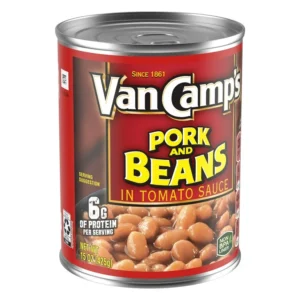 Another version says that Hester herself made the change. According to Robert R. Smith of Fishers, Indiana—Hester Van Camp’s great, great-nephew—in a 2006 email to the Los Angeles, Metropolitan News-Enterprise, “She modified an old Raymond family recipe by adding tomato sauce.”
Another version says that Hester herself made the change. According to Robert R. Smith of Fishers, Indiana—Hester Van Camp’s great, great-nephew—in a 2006 email to the Los Angeles, Metropolitan News-Enterprise, “She modified an old Raymond family recipe by adding tomato sauce.”
Whatever the truth, a 1935 trademark application states that Gilbert and his eldest son Cortland Van Camp began selling their beans in tomato sauce sometime between 1882 and 1885, marketing them as “Boston Baked Beans Prepared in Tomato Sauce,” In their first year, they sold over 67,000 cans. The product’s success led to aggressive expansion, and by the early 1900s, Van Camp was the nation’s dominant pork and bean brand, operating six plants nationwide.
After 70 successful years, Van Camp Canning was sold in 1933 to James and John Stokely, who renamed it Stokely-Van Camp Inc. Yet the flagship brand, Van Camp’s pork and beans, remain on store shelves to this day.
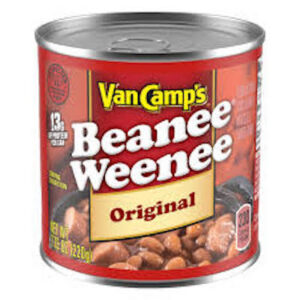 The company even makes a version with sliced hot dogs—under the name of Beanee Weenee. (Fun fact: July 13 is National Beans ’n Franks Day.)
The company even makes a version with sliced hot dogs—under the name of Beanee Weenee. (Fun fact: July 13 is National Beans ’n Franks Day.)
Other Iconic American Canned Bean Brands:
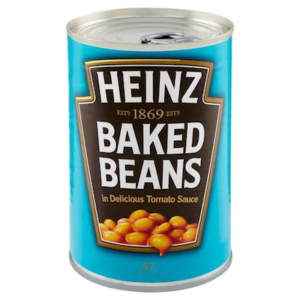 H. J. Heinz Company began canning Boston Baked Beans with tomato sauce in 1886. It was one of the first American food products marketed overseas.
H. J. Heinz Company began canning Boston Baked Beans with tomato sauce in 1886. It was one of the first American food products marketed overseas.
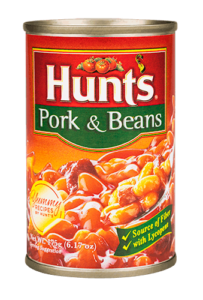 Hunt Foods, founded in 1888, added pork and beans to its product line in 1941. By the early 1950s, Hunt’s was selling pork and beans, tomato sauce, and catsup throughout the Philippines—where its beans still command 86% of the market.
Hunt Foods, founded in 1888, added pork and beans to its product line in 1941. By the early 1950s, Hunt’s was selling pork and beans, tomato sauce, and catsup throughout the Philippines—where its beans still command 86% of the market.
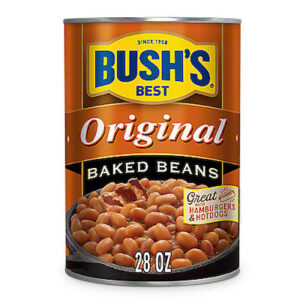 Bush Brothers & Company was started in 1897, but it wasn’t until 1969 that Fred Bush, C.J. Ethier (his son-in-law), and grandson Condon Bush developed the baked bean recipe that became Bush’s Best. Today, it’s the most popular brand in America.
Bush Brothers & Company was started in 1897, but it wasn’t until 1969 that Fred Bush, C.J. Ethier (his son-in-law), and grandson Condon Bush developed the baked bean recipe that became Bush’s Best. Today, it’s the most popular brand in America.
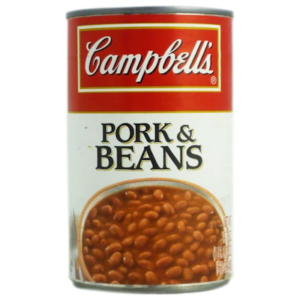 Campbell’s Pork and Beans were originally produced for them by the Van Camp cannery, until 1921 when Campbell’s president, John T. Dorrance, brought production in-house and expanded their soup and bean business.
Campbell’s Pork and Beans were originally produced for them by the Van Camp cannery, until 1921 when Campbell’s president, John T. Dorrance, brought production in-house and expanded their soup and bean business.
Del Monte considered entering the pork and beans market in the 1930s, even printing labels for it, but never released the product. They do offer baked beans in tomato sauce, though details are scarce—it’s known they are currently produced in India
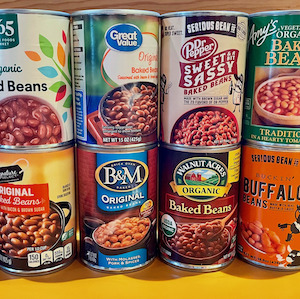 Today you’ll find dozens of canned baked bean varieties on grocery shelfs. Some have bacon or pork, some don’t. Some are sweetened with molasses or brown sugar, and there are even vegetarian options. With so many choices there’s sure to be one that suits to your taste buds.
Today you’ll find dozens of canned baked bean varieties on grocery shelfs. Some have bacon or pork, some don’t. Some are sweetened with molasses or brown sugar, and there are even vegetarian options. With so many choices there’s sure to be one that suits to your taste buds.
But for those with a more adventurous spirit, why not make your own? I’ve included a baked bean recipe I really like, but if it doesn't appeal to you, a Google search with turn up more recipes than you can shake a stick at. Whichever direction you go, I wish you a rootin', tootin’ good time.


